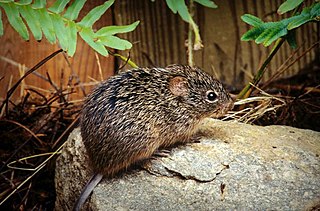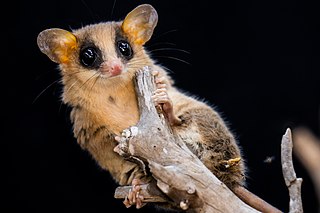
The rodent subfamily Sigmodontinae includes New World rats and mice, with at least 376 species. Many authorities include the Neotominae and Tylomyinae as part of a larger definition of Sigmodontinae. When those genera are included, the species count numbers at least 508. Their distribution includes much of the New World, but the genera are predominantly South American, such as brucies. They invaded South America from Central America as part of the Great American Interchange near the end of the Miocene, about 5 million years ago. Sigmodontines proceeded to diversify explosively in the formerly isolated continent. They inhabit many of the same ecological niches that the Murinae occupy in the Old World.

Oxymycterus is a genus of rat-like rodents commonly known as hocicudos. They are endemic to South America. As of April 2019, the genus contains the following 16 species:

Oligoryzomys nigripes, also known as the black-footed colilargo or the black-footed pygmy rice rat, is a rodent in the genus Oligoryzomys of family Cricetidae. Oligoryzomys nigripes is a species that has been further divided into different sister taxa throughout history. It is found in different countries in South America. It is a large species with long ears, dark yellow to dark brown upperparts, sharply delimited from the whitish underparts, and often a pink girdle on the chest. This species of rat spends much of its life among the trees. The karyotype is 2n = 62, FNa = 78–82.

The Caatinga enclaves moist forests is an ecoregion of the Tropical moist forests Biome, and the South American Atlantic Forest biome. It is located in northeastern Brazil.
Oligoryzomys magellanicus, also known as the Patagonian colilargo and the Magellanic pygmy rice rat, is a species of rodent in the genus Oligoryzomys of the family Cricetidae. It is found in the southernmost parts of Argentina and Chile, including Tierra del Fuego and other outlying islands. Its karyotype has 2n = 54 and FNa = 66.
Coues's climbing mouse is a species of rodent in the family Cricetidae. It is found in Colombia, Ecuador, Peru, Trinidad and Tobago, and Venezuela. It is named in honour of the American zoologist Elliott Coues who studied birds and small mammals.
The buff-bellied climbing mouse is a species of rodent in the family Cricetidae. It is found in Colombia and Venezuela.
The yellow-bellied climbing mouse is a species of arboreal rodent in the family Cricetidae. It is known only from southeastern Peru, where it has been found in cloud forest at an elevation of 1830 m. This species was long known only by the type collection until it was rediscovered in May 2010.

Thomasomys is a genus of rodents in the family Cricetidae, named after British zoologist Oldfield Thomas. Nuclear DNA sequence analysis has indicated that it is a sister taxon to Rhagomys. It contains the following species:

Gracilinanus is a genus of opossum in the family Didelphidae. It was separated from the genus Marmosa in 1989, and has since had the genera Cryptonanus, Chacodelphys, and Hyladelphys removed from it.
Oligoryzomys moojeni is a species of rodent from South America in the genus Oligoryzomys of family Cricetidae. It is known only from central Brazil, where it is found in the cerrado and gallery forests. It is named after twentieth-century Brazilian zoologist João Moojen. Its karyotype has 2n = 70 and FNa = 84.

The Atlantic Forest climbing mouse is an arboreal rodent species in the family Cricetidae from South America. It is found in the Atlantic Forest of southeastern Brazil at elevations from sea level to 1500 m. It utilizes the ground more than the understory in isolated forests however this utilization changes in certain areas of the Atlantic Forest where it prefers to use the vegetation canopy. Its karyotype is 2n = 44, FN = 74–80.

The cerrado climbing mouse or long-tailed rhipidomys is an arboreal rodent species in the family Cricetidae from South America. It is found in primary or secondary forests of the cerrado and caatinga in central and eastern Brazil, and has also been seen in the Atlantic Forest. Its karyotype is 2n = 44, FN = 48-52. They are nocturnal animals and can be found in both tree canopies and on the ground.
Cerradomys scotti, also known as Lindbergh's oryzomys, is a rodent species from South America in the genus Cerradomys. It is terrestrial and is found in the cerrado (savanna) ecozone of south central Brazil, Bolivia and Paraguay. The species is common and appears to tolerate a degree of agricultural habitat modification.
The Cariri climbing mouse is a partly arboreal rodent species from South America. It is known from two mesic localities in Ceara, northeastern Brazil, within the semiarid caatinga ecoregion. It has been found in areas under cultivation. Cariri is the name of an administrative microregion within the state of Ceará.
The eastern Amazon climbing mouse is a rodent species from South America. It is endemic to central Brazil, where it is found in the eastern fringe of the Amazon rainforest, as well as in gallery forest and tropical dry forest within the cerrado ecoregion. It is often found in areas under cultivation.
Rhipidomys ipukensis, also known as the Ipuca climbing rat, is a species of rodent in the family Cricetidae. It is endemic to the state Tocantins of Brazil.
Rhipidomys itoan, also known as the sky climbing rat, is a species of rodent in the family Cricetidae.It is endemic to the Atlantic Forest of Brazil.
Rhipidomys tribei, also known as the Tribe's climbing rat, is a species of rodent in the family Cricetidae. It is endemic to the state Minas Gerais of Brazil.
The Ybyra climbing rat is a newly described species of rodent in the family Cricetidae. It is found in Brazil.








